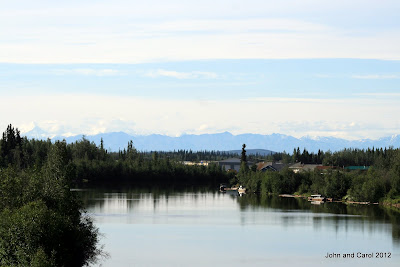
When everybody says, "you must do this," we often wonder. But, since our Toursaver book has a buy one-get one free coupon, we gave it a try. The coupon book cost $100. A ticket on the boat cost $54.95. That means we have recouped $55 of our $100. So it was worth it. And the trip today was worth it. First off, we watched a float plane take off from the river. In the background, you see Discovery I, Binkley's first sternwheeler.

Then he made a great landing.

The three-hour tour took us down the Chena (pronounced Cheena) River to where it meets the Tanana River. Discovery III is a flat-bottomed boat that only needs 39" of water. Today the Chena was beautiful and smooth.

We stopped beside the sled dog kennels of Susan Butcher, who won the Iditarod Dog Sled Race four times, quite an accomplishment for a woman in a man's sport. Sled dog racing is Alaska's most important and/or popular sport. Susan died in 2006 from leukemia, but her husband, Dave Monson, still raises dogs there. John and I didn't think we would be interested in sled dogs. But we saw month-old puppies learning to trust their handlers and a team of dogs so eager to pull that they leaped and jumped when they heard Dave's voice. It was amazing to see how much they wanted to run. They pulled him, riding on a motor-less ATV. Total weight over 600 pounds. In a race, the sled and driver weigh much less than that, maybe 205 pounds. In this photo, handlers are getting the dogs ready to pull.

Here you see the dogs right before Dave released the ATV and took the brake off. Boy did they move out!

The water in the Tanana River is fed by glaciers. When it mixes with the water of Chena, you see the fine silt the glacier scours off the ground "bloom" out as the two rivers mix. It is really pretty amazing.

This is another picture of the Chena, looking back upstream, away from the Tanana.

We were able to get off the boat for an hour-long stop at Chena Village, a re-creation of an original Chena Athabascan Indian Village of the early 1900s. It is similar to those that the first Binkley steamboat captain, Charlie, and others would have seen during the gold rush in the late 1800s and early 1900s.
We saw a fish wheel, which helped the Athabascans take lots of salmon from the river without a fishing pole. It turns with the river current, scooping up salmon during the annual runs upriver.

This is Hanna, a native Eskimo-Athabascan (I think) who is a college student in Fairbanks and works both on the Discovery III and as an interpreter at Chena Village. She is explaining how they would fillet the salmon, then hang them here till they stop dripping fluids. You see drip-dry salmon fillets.

Here you can see how they fillet is sliced through to the skin, exposing more of the flesh to the smoke.

The next stage was to smoke the salmon over alder fires to preserve it. The first run of the summer is Chum salmon, which they consider an inferior fish. It is dried and used mainly for dog food. Given the great number of sled dogs in Alaska, this is an important use of fish.
After learning some western ways from the Russian explorers who came to Alaska before the gold rush, the natives started moving to fish camps in the summer to harvest the salmon. Previously, they had lived a nomadic lifestyle. They used birch-bark canoes like this one to travel.

Here you can see inside a tent at the fish camp, with pine boughs on the ground and a mosquito net over the sleeping area.

We also learned about the importance of animal hides and fur in the life of the Eskimos and other natives. Nothing was wasted. The flesh was eaten, the fur and hide used for clothing and shelter. Even the antlers were sliced and used as buttons. Tails are used for decoration. Look at this beautiful parka. I think it is called a sun parka because of the halo of fur around the woman's face when the hood is up. They used linx fur (I think) around the face because it has an oily surface that prevents the wearer's breath from making frost on the hood.

They keep some reindeer at Chena Village. Did you know that caribou are called reindeer when they are domesticated? If you look closely, you can see the front reindeer has a very smooth coat. The others in the picture are still shedding their winter coat and look kind of ratty.

I'm not sure if it is because the long winters here encourage the residents to enjoy what grows in the summer, or because the many hours of sunlight each day, but we see hanging flower baskets and pots of flowers everywhere. Here is a basket on the landing where we boarded Discovery III.


No comments:
Post a Comment